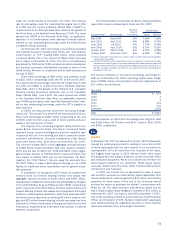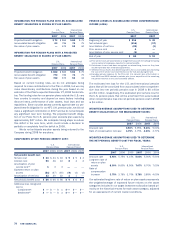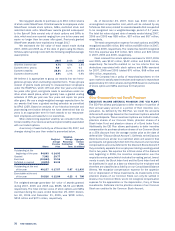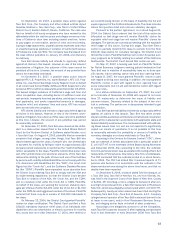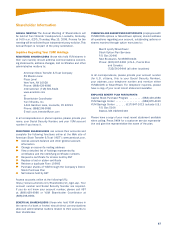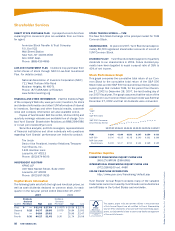Pizza Hut 2007 Annual Report Download - page 77
Download and view the complete annual report
Please find page 77 of the 2007 Pizza Hut annual report below. You can navigate through the pages in the report by either clicking on the pages listed below, or by using the keyword search tool below to find specific information within the annual report.
81
22.
Guarantees, Commitments and Contingencies
LEASE GUARANTEES AND CONTINGENCIES As a result of (a)
assigning our interest in obligations under real estate leases as
a condition to the refranchising of certain Company restaurants;
(b) contributing certain Company restaurants to unconsolidated
affiliates; and (c) guaranteeing certain other leases, we are fre-
quently contingently liable on lease agreements. These leases
have varying terms, the latest of which expires in 2026. As of
December 29, 2007, the potential amount of undiscounted
payments we could be required to make in the event of non-
payment by the primary lessee was approximately $400 million.
The present value of these potential payments discounted at our
pre-tax cost of debt at December 29, 2007 was approximately
$325 million. Our franchisees are the primary lessees under the
vast majority of these leases. We generally have cross-default
provisions with these franchisees that would put them in default
of their franchise agreement in the event of non-payment under
the lease. We believe these cross-default provisions significantly
reduce the risk that we will be required to make payments under
these leases. Accordingly, the liability recorded for our probable
exposure under such leases at December 29, 2007 and Decem-
ber 30, 2006 was not material.
FRANCHISE LOAN POOL GUARANTEES We have provided a par-
tial guarantee of approximately $12 million of a franchisee loan
pool related primarily to the Company’s historical refranchising
programs and, to a lesser extent, franchisee development of new
restaurants, at December 29, 2007. In support of this guarantee,
we have provided a standby letter of credit of $18 million under
which we could potentially be required to fund a portion of the
franchisee loan pool. The total loans outstanding under the loan
pool were approximately $62 million at December 29, 2007.
The loan pool is funded by the issuance of commercial
paper by a conduit established for that purpose. A disruption in
the commercial paper markets may result in the Company and
the participating financial institutions having to fund commercial
paper issuances that have matured. Any funding under the guar-
antee or letter of credit would be secured by the franchisee loans
and any related collateral. We believe that we have appropriately
provided for our estimated probable exposures under these con-
tingent liabilities. These provisions were primarily charged to net
refranchising (gain) loss. New loans added to the loan pool in
2007 were not significant.
All outstanding loans in another franchisee loan pool we
previously partially guaranteed were paid in full during 2007. No
further loans will be made from this loan pool.
UNCONSOLIDATED AFFILIATES GUARANTEES From time to time
we have guaranteed certain lines of credit and loans of unconsoli-
dated affiliates. At December 29, 2007 there are no guarantees
outstanding for unconsolidated affiliates. Our unconsolidated
affiliates had total revenues of $1.4 billion for the year ended
December 29, 2007 and assets and debt of approximately $665
million and $22 million, respectively, at December 29, 2007.
INSURANCE PROGRAMS We are self-insured for a substantial
portion of our current and prior years’ coverage including work-
ers’ compensation, employment practices liability, general liability,
automobile liability and property losses (collectively, “property
and casualty losses”). To mitigate the cost of our exposures for
certain property and casualty losses, we make annual decisions
to self-insure the risks of loss up to defined maximum per occur-
rence retentions on a line by line basis or to combine certain lines
of coverage into one loss pool with a single self-insured aggre-
gate retention. The Company then purchases insurance coverage,
up to a certain limit, for losses that exceed the self-insurance
per occurrence or aggregate retention. The insurers’ maximum
aggregate loss limits are significantly above our actuarially deter-
mined probable losses; therefore, we believe the likelihood of
losses exceeding the insurers’ maximum aggregate loss limits
is remote.
In the U.S. and in certain other countries, we are also self-
insured for healthcare claims and long-term disability for eligible
participating employees subject to certain deductibles and limita-
tions. We have accounted for our retained liabilities for property
and casualty losses, healthcare and long-term disability claims,
including reported and incurred but not reported claims, based
on information provided by independent actuaries.
Due to the inherent volatility of actuarially determined prop-
erty and casualty loss estimates, it is reasonably possible that
we could experience changes in estimated losses which could
be material to our growth in quarterly and annual net income. We
believe that we have recorded reserves for property and casualty
losses at a level which has substantially mitigated the potential
negative impact of adverse developments and/or volatility.
LEGAL PROCEEDINGS We are subject to various claims and
contingencies related to lawsuits, real estate, environmental and
other matters arising in the normal course of business. We pro-
vide reserves for such claims and contingencies when payment is
probable and estimable in accordance with SFAS No. 5, “Account-
ing for Contingencies.”
On November 26, 2001, a lawsuit against Long John Silver’s,
Inc. (“LJS”) styled Kevin Johnson, on behalf of himself and all others
similarly situated v. Long John Silver’s, Inc. (“Johnson”) was filed in
the United States District Court for the Middle District of Tennes-
see, Nashville Division. Johnson’s suit alleged that LJS’s former
“Security/Restitution for Losses” policy (the “Policy”) provided
for deductions from Restaurant General Managers’ (“RGMs”)
and Assistant Restaurant General Managers’ (“ARGMs”) sala-
ries that violate the salary basis test for exempt personnel under
regulations issued pursuant to the U.S. Fair Labor Standards
Act (“FLSA”). Johnson alleged that all RGMs and ARGMs who
were employed by LJS for the three year period prior to the law-
suit—i.e., since November 26, 1998—should be treated as the
equivalent of hourly employees and thus were eligible under the
FLSA for overtime for any hours worked over 40 during all weeks
in the recovery period. In addition, Johnson claimed that the
potential members of the class are entitled to certain liquidated
damages and attorneys’ fees under the FLSA.
LJS believed that Johnson’s claims, as well as the claims
of all other similarly situated parties, should be resolved in indi-
vidual arbitrations pursuant to LJS’s Dispute Resolution Program
(“DRP”), and that a collective action to resolve these claims in
court was clearly inappropriate under the current state of the law.
Accordingly, LJS moved to compel arbitration in the Johnson case.
The Court determined on June 7, 2004 that Johnson’s individual
claims should be referred to arbitration. Johnson appealed, and
the decision of the District Court was affirmed in all respects
by the United States Court of Appeals for the Sixth Circuit on
July 5, 2005.


